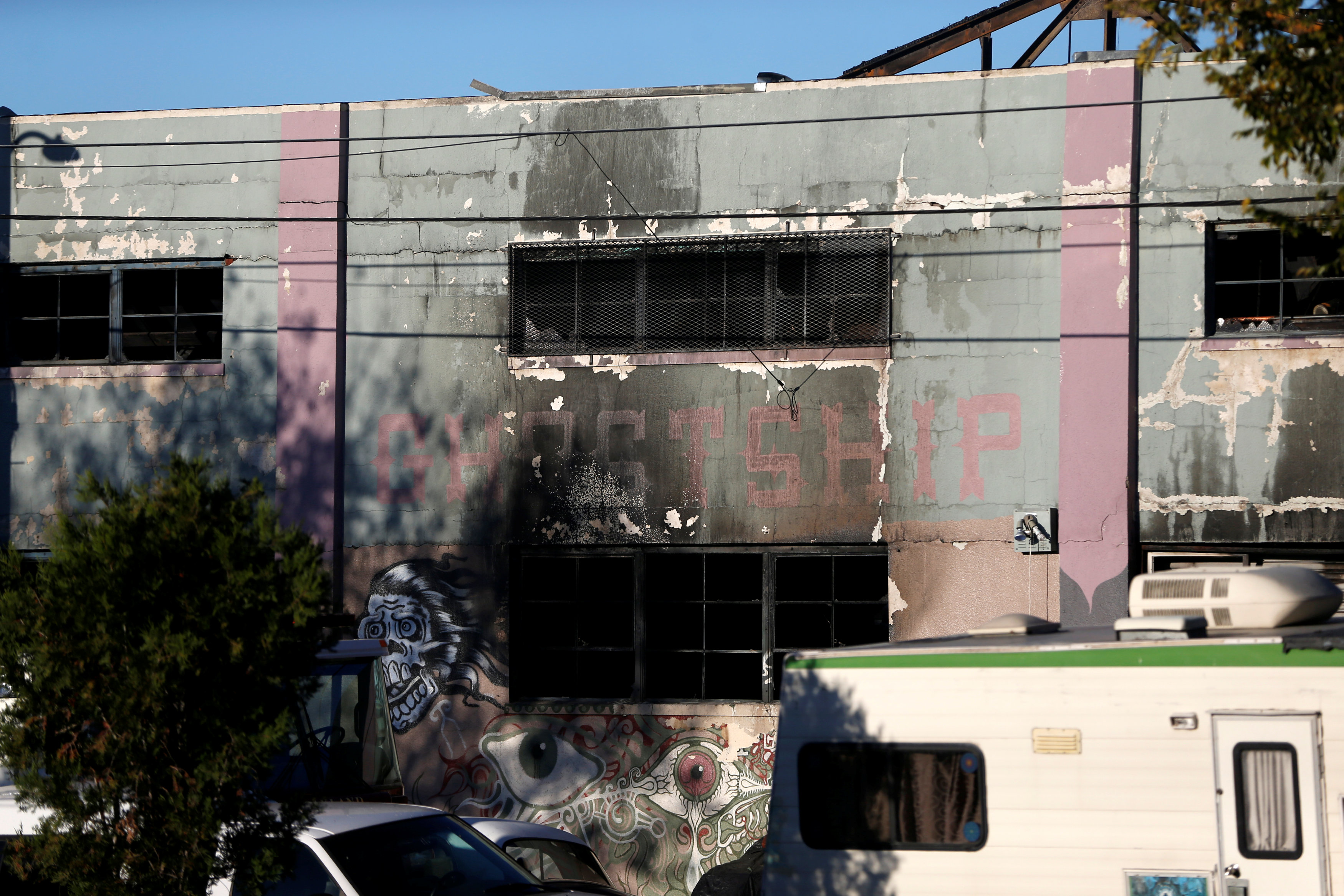
By Rory Carroll
OAKLAND, Calif. (Reuters) – A grim search for victims of a devastating fire that ripped through a converted warehouse in Oakland, California during a dance party entered a third day on Monday, with the list of 33 known deaths expected to grow.
The blaze, which erupted about 11:30 p.m. on Friday (0730 GMT on Saturday), ranks as the deadliest in the United States since 100 people perished in a 2003 Rhode Island nightclub fire.
As criminal investigators joined recovery efforts at the charred ruin, just east of San Francisco, firefighters found the remains of nearly three dozen victims at the weekend as they searched the debris-filled shell of the two-story converted warehouse being used by an artists’ collective.
The cause of the fire was still undetermined, officials said. Arson is not suspected but investigators are checking whether the building, often used for music performances, had a history of code violations.
Mayor Libby Schaaf said the Alameda County District Attorney’s Office activated its criminal investigation team at the fire scene. A representative of the prosecutor’s office is monitoring the recovery process, she said, adding she was not authorized to say if a criminal probe was under way.
The mayor said the city’s first priority was finding the victims and supporting their families, adding, “We have delivered the unacceptable and horrific news of losing a loved one to seven of our families.”
The warehouse, which served as a base for the Ghost Ship Artists Collective, was one of many converted lofts in the city’s Fruitvale district, a mostly Latino area where rents are generally lower than in the rest of Oakland.
By Sunday evening, only 35 to 40 percent of the building had been searched, said Sergeant Ray Kelly, spokesman for the Alameda County Sheriff’s Office.
Officials are still unsure how many people were in the building at the time.

A woman places flowers at a makeshift memorial near the scene of a fire in the Fruitvale district of Oakland, California, U.S. December 3, 2016. REUTERS/Stephen Lam
SOME VICTIMS AGED 17 OR YOUNGER
Recovery teams had yet to search an unspecified number of mobile homes parked on the first floor, Kelly said, illustrating the scope of the task. He said people appeared to have been living in them.
The building was designated for use as a warehouse only, according to the city, which was aware of reports that people were living there, although no permits had been issued.
The recovery operation was delayed for hours as the roof collapsed and the second story fell onto the first in spots, making it unsafe to enter.
The effort has proceeded slowly due to mountains of debris, with victims apparently scattered throughout the unstable structure.
“We’re finding victims in every quadrant of the warehouse,” Kelly said. “We’re finding victims where we least expect them.”
Exhaustion and the wide scale of the disaster were taking an emotional toll on crews who had been working around the clock since the fire broke out.
With many victims burned beyond recognition, families were asked to preserve items that might contain their DNA to aid identification.
After notifying their families, the Alameda County coroner released the names of seven victims who had been positively identified:
– Cash Askew, 22, Oakland, Calif.
– David Clines, 35, Oakland, Calif.
– Nick Gomez-Hall, 25, Coronado, Calif.
– Sara Hoda, 30, Walnut Creek, Calif.
– Travis Hough, 35, Oakland, Calif.
– Donna Kellogg, 32, Oakland, Calif.
– Brandon Chase Wittenauer, 32, Hayward, Calif.
Some of the victims were aged 17 or younger, although most were in their 20s and 30s, officials said. Some were from elsewhere in the United States and abroad.
One of the dead was the son of a sheriff’s deputy, Kelly said, adding, “This tragedy has hit very close to home.”
Chris Nechodom, 30, said he was on the ground floor of the building when he saw flames race across the ceiling. As he fled, he heard a loud noise and saw a plume of thick black smoke.
“It blew out maybe 10 feet out of the entrance. After that, I saw a few more people crawl out.” Nechodom said he was unsure how many people had been inside.

Rachel Saxer (L) embraces friend La Tron at a makeshift memorial near the scene of a fatal warehouse fire in the Fruitvale district of Oakland, California, U.S. December 4, 2016. REUTERS/Stephen Lam
‘SET UP FOR A FIRE’
Photos of the ‘Ghost Ship’ venue posted online showed a space filled with an elaborate array of musical instruments, religious statues and antiques. Furnished with a mix of overstuffed sofas and colorful carpets, the site featured a maze of side rooms and nooks.
“The whole place was built like you are going to set up for a fire,” said Matt Hummel, 46, who twice visited the space before the fire and had helped renovate other warehouse spaces for artists.
The party took place on the second floor of the building, which appeared to have only two exits, officials said. There was no evidence of smoke detectors or sprinklers.
The city said it had received complaints about “blight” and construction without permits and opened an investigation. An inspector verified the “blight” complaint after observing piles of debris outside, but failed to gain access to verify the construction complaint.
Schaaf told reporters she did not know why inspectors were unable to get into the building, but she was putting together a team of city employees “to gather every piece of information.”
(Additional reporting by Tim McLaughlin in Chicago and Sharon Bernstein in Sacramento, Calif.; Writing by Frank McGurty; Editing by Peter Cooney)












